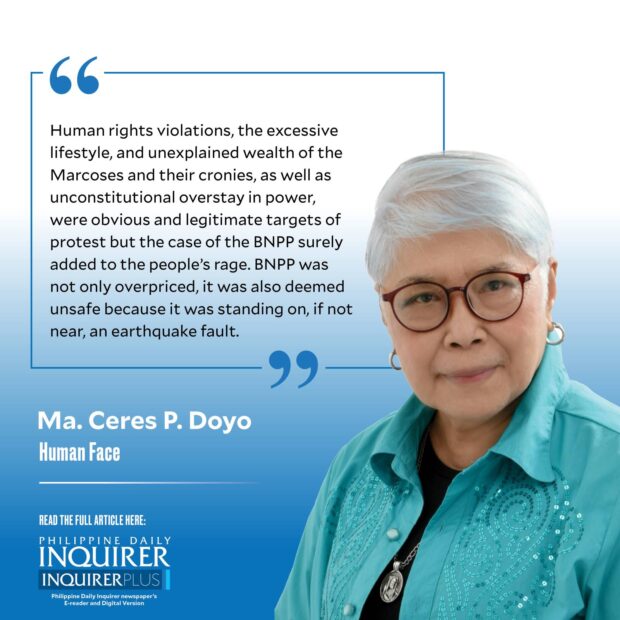
Forget me not” sounds like a cheeky catchphrase but some civil society groups are using it to revisit the 1986 Edsa People Power Revolution phenomenon that ousted the Marcos dictatorship that ruled for 14 years. That is not counting the previous seven years he had sat as elected president. Two days from now, on Feb. 25, the people revolt that began on Epifanio de los Santos Ave. (Edsa) and sparked similar uprisings in different parts of the country will be celebrating its 38th anniversary.
It seems like a lifetime ago. “Forget Me Not” is a breather from the feisty “Never Again, Never Forget” that conjures up raised fists and protest flags flying against the wind. “No to forgetting” tugs at the heart. “Remembering” has a liturgical ring to it, as in “We remember, we celebrate, we believe” and “Do this in remembrance of me.” Take your pick.
But anniversary activities are aplenty. Early tomorrow morning, you may want to visit the Bantayog ng mga Bayani complex (Quezon Ave., corner Edsa) for yellow ribbon-tying and other sprucing-up activities.
There were countless issues that bedeviled the Marcos authoritarian rule that presaged its inglorious downfall—the excesses and abuses that defined it. One of them was the construction of the $2.3-billion Bataan Nuclear Power Plant (BNPP) in Morong, Bataan, that has since been mothballed for various reasons, safety and corruption among them. $2.3 billion was a staggering amount at that time, not to mention the interest it accrued every day. The BNPP complex now stands there in a sorry state of disrepair and neglect, like the ghost shadows of those who had personally profited from their dealings with Westinghouse Electric Corp., the company that was building it. I had written about this a number of times in the past and each time I had to dig into my files because of the complexity of the issues surrounding it.
Human rights violations, the excessive lifestyle, and unexplained wealth of the Marcoses and their cronies, as well as unconstitutional overstay in power, were obvious and legitimate targets of protest but the case of the BNPP surely added to the people’s rage. BNPP was not only overpriced, it was also deemed unsafe because it was standing on, if not near, an earthquake fault.
In the news yesterday was the Supreme Court (SC) decision reducing “the damages in the Disini-BNPP case.” The front-page teaser: “The [SC] has reduced from P1 billion to P100 million the damages to be paid by the estate of Herminio Disini, a crony of the late dictator Ferdinand Marcos Sr. and broker of the graft-ridden Bataan Nuclear Power Plant deal in 1974. The court denied with finality the motion for reconsideration on its 2021 decision in the Disini case but it revisited portions pertaining to the amount of damages” (“From P1B to P100M: SC reduces damages in Disini-BNPP case,” News, 2/22/24).
No mincing of words there but why does the story give one a hangdog feeling? Citizens of this country often get the short end of a decision in matters of ill-gotten wealth and such. Do the scoundrels in our midst ever reap the whirlwind? No matter, at least the decision clearly established that there are damages to be paid and therefore a crime had been committed.
Whoever is getting sentimental about reviving the BNPP in this day of alternative sources of energy and while some countries are decommissioning theirs, must have something up their sleeves. Nuclear weapons are another story and people like former senator Juan Ponce Enrile and Sen. Robin Padilla want to scrap the constitutional provision (Section 8) banning nuclear weapons in the country. From the frying pan to the fire?
“The Bataan Nuclear Power Plant: A monument to man’s folly” subtitled “Pride and refusal to admit mistakes” by distinguished statesman, nationalist, and former senator Lorenzo M. Tañada explained the XYZ of it all. Jose W. Diokno, also a great nationalist and former senator, wrote the foreword. Tañada’s treatise was well-based on facts. It cited the Puno Commission’s findings: “that the plant was not safe, that is was on old design plagued with unresolved safety issues, that safety was not assured, and that the crucial problem of nuclear waste disposal had not been resolved. Despite these, construction suspension was lifted in 1980.”
But Tañada could not get hold of the contract with Westinghouse at that time because, he was told that “it was confidential.” He raged, asking how something so huge and involving people’s money would be shrouded in secrecy.
There is more we need to know about the SC’s decision. P100 million in “temperate damages” is a pittance. How it was arrived at is for legal number crunchers to figure out. The SC also cleared the Marcoses from involvement in the onerous deal. Only the Disini estate (petitioning to be declared innocent) was held liable.
Have a memorable weekend. I know where I was during those three days 38 years ago. I was with media colleagues in Camp Aguinaldo on the night of Feb. 22, 1986, when the anti-Marcos military breakaway was announced. The die was cast. I did fear that helicopter gunships would come and blow us all to smithereens.
—————-
Send feedback to cerespd@gmail.com